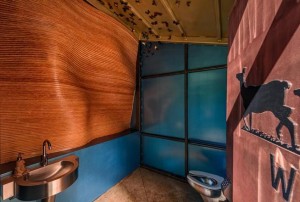Shortly after today’s horrific incidents in Paris, the Washington Capitals flooded their arena in the colors of the French flag; a classy move.
My thoughts are with those in Paris too.

Your organic steel cut oats & chia with flax and rye flakes might have Salmonella in it, if it’s from Homestat Farms.
Homestat Farm of Dublin, OH is recalling some of its 42-ounce packages only of “Organic Steel Cut Oats & Chia with Flax And Rye Flakes” because the flax seed ingredient has the potential to be contaminated with Salmonella.
The recalled “Organic Steel Cut Oats & Chia with Flax And Rye Flakes” was distributed on a limited basis in Sams Club retail stores located in AK, CA, FL, GA, IL, IN, KS, MD, MI, MN, MS, NC, NH, OH, PA & TX.
The product comes in a 42 ounce carton UPC 8 35882 00620 4 marked with Best Buy: 03/16/17-1, 03/16/18-1, 03/19/17-1, 03/19/17-2, 03/23/17-1, 03/23/17-2, 03/24/17-1, 03/26/17-1, 03/26/17-2, 04/08/17-2. The best buy date can be found embossed on the bottom flap of box next to the bar code.
A supplier informed Homestat Farm of this after a contamination was found in flax seed provided to another customer.
That product sounds like something that Drunk Uncle might say. It probably goes well with some swiss chard on a Roku or an Amazon Prime pumpkin spice.
A good food safety culture (a term as ubiquitous as Drake’s Hotline Bling) is really about having all the staff in an organization know what hazards are associated with the food they make/handle from the owner, to management, to the front line staff. And when someone is sick, or gets fired, whoever steps into the role as a replacement. Managers have to know what’s needed to keep food safe – and ensure their staff are actually doing it.
KTNV has a great video of a poor inspection that tells the story of a poor food safety culture.
Inspectors found visibly dirty food contact surfaces, old food debris on the can opener and meat slicer and a dirty ice machine. There was also heavy debris on the floor under kitchen equipment, a badly stained cutting board, and no hair restraints for food handlers.
“A lot of things I didn’t know,” said temporary manager Angela Liu. She says she’s not used to overseeing the kitchen staff and admits she didn’t check everything the night before their unannounced inspection.
Inspectors also found a full handsink leaking dirty water. And food in the prep table not protected from contamination. Angela takes us back to show us what is now a much cleaner kitchen.
She says the owner made it clear that he never wants to see another “C” grade.
And then this excellent dialogue happens.
Angela: If C again, they all lose their job.
Darcy: That’s it. Everyone’s job’s on the line.
She shows us how everything is now labeled and double-covered to keep inspectors happy and customers healthy.
Darcy: It’s about food safety.
Angela: Yeah, food safety. Right. It’s very serious. Oh, my god. (she pauses to swat away a fly buzzing around her face.)
Darcy: You don’t want a fly in here, do you?
I play hockey with a bunch of technology nerds and last night’s post game dressing room chatter included a discussion on recalled emails. Instead of the intended message of ‘oh, I made a mistake, don’t read that last one,’ it leads to increased attention and urgency in reading the recalled message to see what the sender didn’t want you to see.
Sort of like telling someone not to Google something likely leads to that person immediately Googling it.
That’s what a school in the UK did in an effort to reduce panic after 20 cases of hepatitis A was identified in a couple of schools, according to the Yorkshire Evening Post.
An outbreak of Hepatitis A in two Leeds schools has seen national health chiefs offer mass vaccinations in the LS9 area.
Public Health England (PHE) stepped in after around 20 cases of the rare virus were confirmed in the area, sparking a vaccination program that will impact thousands of school staff and residents.
The YEP understands that the 630-pupil Richmond Hill Primary School, in Clark Lane, and 460-pupil Brownhill Primary Academy, in Torre Drive, are the two schools where all staff and pupils are being immunized.
A message put out to parents at Richmond Hill Primary School urges them not to “panic” over the situation. It reads: “We strongly advise you not to Google search ‘Hepatitis A’ as you may access inaccurate and possibly worrying information.”
PHE is working with Leeds City Council and the NHS in Leeds to vaccinate those most likely to have come into contact with the carriers. Around 300 people have taken up the vaccine when offered so far, and PHE is stressing that anyone who has not yet been offered the vaccination does not need it at the current time.
There were only 367 reported cases of Hepatitis A infection in England and Wales during 2010.
I Googled hepatitis A and found some good information sources.
Nuts and other low moisture foods can be a source of Salmonella. That’s not new. But many folks in the low-moisture foods industries are now conducting risk assessments and validating interventions (like pasteurization) to keep the Salmonella out of the hands of bar patrons everywhere.
The almond industry led the way about a decade ago. The peanut industry, in the wake of two outbreaks followed. According to Growing Produce, the pistachio industry is working with friend of barfblog (and known to her close friends as at the almond queen) Linda Harris and Michigan State’s Bradley Marks on some validation work.
“At this point in our world, Salmonella is a hazard that is reasonably likely to possibly occur in low-moisture products like nuts. It’s happened before, so we have to assume it’s possible it could happen again,” Marks says. “That being the case, the proposed rules of FSMA require that the processor have a validated process that they can document that they’ve shown achieves the food safety objective.”
Marks and his colleagues are currently working on lab-scale research to evaluate the effects of the pasteurization process and product conditions on the resistance of Salmonella to heating. “We’re doing some mathematical modeling so we can understand the rate of Salmonella activation as a function of temperature, time, and conditions of the product or the process itself,” Marks says.
The second part of the project will involve similar work on a pilot scale. “We have a system where we can inoculate pistachios with Salmonella and subject them to a process like a flatbed roaster,” Marks says. “So we are looking at validating that our prediction of the inactivation of Salmonella is correct, and that a non-pathogenic surrogate (Enterococcus faecium) also is reliable as a means to validate the process.”
Marks is working closely with Linda Harris, co-principal investigator for the Western Center for Food Safety at the University of California, Davis, to develop guidelines and on-site workshop training for pistachio processors. The guidelines and training will focus on what needs to be measured and documented to meet the FSMA requirements.
Our weekends are dominated by hockey. Jack, the 7-year-old, practices early Saturday morning with games are Sundays. Sam, the 5-year-old, starts a learn to play hockey class this weekend.
Last year I went through 8 hours of in-class instruction and 10 hours of online modules to qualify as a volunteer assistant coach. The worse thing I can do is accidentally hit a kid in the helmet with a puck or fall on one (both of those things have happened this year) but the training is required – and it made me a better coach.
It’s not like I’m handling food that people eat, where if I mess up people could get sick and die.
According to KHON2, Hawaiian health department folks are looking at mandatory food safety education for all food establishments in response to a bunch of poor inspections (maybe this is manager training, maybe for all food employees; I’m not sure).
The state health department says it may soon be asking food establishments to undergo mandatory food safety education in wake of a string of “red-carded” Oahu businesses in October.
Of the over 10,000 restaurant inspections done statewide since July 2014, the DOH says 2,000 restaurants had two or more critical violations. So what has the state learned since the placard system for food establishments was put in place? “One thing in our rules we’re probably going to change later on in the year is have a mandatory food safety education for all restaurants and food establishments in Hawaii,” said Peter Oshiro with the Department of Health.
Since fixing their violations, the North Shore bakery says it’s busier than usual.
“That’s great for the bakery,” Oshiro said. “For us, all we’re concerned with is that they correct violations that impact public health.”
Inspectors also discovered employees were not following proper hygiene or hand-washing rules, something Oshiro says is considered, “one of the most common violations in food establishments.”
“It looks like they may need some form of food safety education so hopefully they might agree to something like that,” Oshiro said.
Powell famously rated Guelph bathrooms in the 1980s while editor of the University of Guelph’s campus paper, The Ontarion. His idea was resurrected by supply and uniform company, Cintas and according to the Denver Post, a Minturn, Colorado restroom has won the most artsy award (or something like that).
Holding back chuckles, [Minturn planning director Janet] Hawkison said there has been a great sense of humor and jokes around town about being known for their toilets. The town is just happy that a project that was such a big part of the community had its time to shine.
The two restrooms, one for men and one for women, sit a few feet apart and feature fabricated wood pieces — 320 different pieces total — on the sides where they face each other to mimic an adit, or an entrance to a mine in honor of Minturn’s rich mining history. Inside the bathrooms, walls are painted turquoise and copper and feature steel butterflies on the ceiling. Conception, design and construction were all done locally.
Curious parties want to see the award winning handwashing tools and signs.
When I was about 7 I poured a bowl of cereal, added milk and started to chow down. I freaked out when I chewed something that wasn’t a Honey Nut Cheerio; I looked down and saw three maggots in the bowl.
I didn’t eat cereal for a few months after the incident.
According to the Sun, a Dublin McDonald’s patron, Anna Potterton, found a maggot in a fry.
The revolted customer said she bought the Happy Meal from the McDonald’s branch on Grafton Street in Dublin.
She said: “One of the chips looked like it had a burnt spot in the middle, but when I looked closer I realised it was some sort of worm or maggot.”
 Shockingly Anna goes on to suggest this seems to be a regular problem at the fast food chain, as when she asked for a refund – which was given without any questions – the cashier said: “Sorry about that, it happens very, very often.”
Shockingly Anna goes on to suggest this seems to be a regular problem at the fast food chain, as when she asked for a refund – which was given without any questions – the cashier said: “Sorry about that, it happens very, very often.”
A spokesperson from the fast food chain said: “McDonald’s Ireland has been contacted by a customer regarding an apparent potato defect in a serving of fries in our Grafton Street Restaurant. The matter is now being looked into. McDonald’s Ireland sources real, whole potato fries from our longstanding supplier McCain’s in the UK.
At a Remembrance Day service in the UK (that’s what the British Commonwealth calls Veteran’s Day) took a barfy turn today when, according to the Daily Star, a soldier fell ill, and yacked on a fellow service member.
The unflappable trooper was snapped covered in what appears to be bright yellow puke after a fellow serviceman fell ill this morning.
Despite being blasted with bile, the soldier steadfastly maintained his composure as the nation paused to pay its respects.
The unlucky soldier, whose identity is currently unknown, was standing close to the Cenotaph when the drama occurred.
Phenomenally, the puked upon guy stood still for the rest of the service.
There’s a lot of amateur epidemiology going on this week. The latest comes from the owner of San Jose’s Mariscos San Juan #3, which reopened yesterday after being linked to 182 illnesses including 12 hospitalizations.
According to ABC 7, owner Segio Cruz says that homeless individuals using his restroom may have introduced the pathogen. Public health folks believe it was a food handler.
“This is first time this happened in my store, I opened my store in 2000,” said Segio Cruz, the restaurant owner.
Cruz owns three restaurants. He says since the shigella outbreak, business has dropped off 70 percent. He says even more damaging is the negative reputation generated by the incident, which he feels his restaurant does not deserve. “You can get sick in your house, your office, anywhere,” insists Cruz.
Cruz said homeless people often use the bathroom inside his restaurant and that perhaps could be another contributing factor. But again, there is still no definitive answers as to what caused this massive, and now mysterious, outbreak.
If his theory is correct, how did the Shigella get from the restroom to the food?